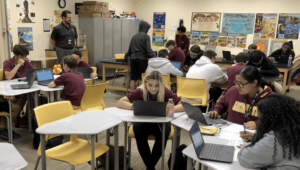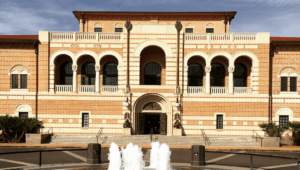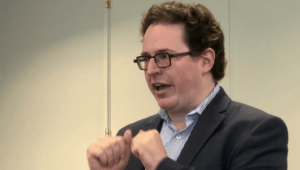ASU Online: Extending Access to HigherEd

ASU Online serves 33,000 students in 150 online degree programs. It extends access to Arizona State University and helps drive the innovation agenda that has brought ASU national recognition.
In the early 2000s, ASU President Michael Crow set ambitious goals to improve quality and extend access. Learning online was an important part of the plan.
When Phil Regier (@philregier) left his role as Executive Dean at the WP Carey School of Business to become Dean for Educational Initiatives in 2009 to manage ASU’s online and extended campuses there were less than 1,000 students learning online. The new goal is 100,000 learners online by 2025.
The Most Innovative University Puts Access First
ASU Online is a program of EdPlus, a university R&D division led by Regier and committed to extending access. In addition to ASU Online, EdPlus offers high-quality courses for professional development and manages components of the ASU partnership with Mayo Clinic to improve medical education and outcomes. EdPlus aspires to reach students all over the world through targeted, open scale channels for degree seekers and life-long learners. These channels include direct to student and partnering with corporations, governments and foundations.
The Global Freshman Academy, an online learning partnership with edX, allows learners to take open classes anytime and only pay after passing a class (about $600 for a three-credit course). It’s a good option for earning inexpensive transferable general education credits from ASU.
There are other universities focused on innovation in digital teaching said Sean Hobson (@seanhobson), Chief Design Officer at EdPlus, but not many with the focus on access, affordability and a culture of innovation.
The EdPlus team focuses on access and quality without sacrificing either. “Scale helps us,” said Hobson. Scale not only supports more investment, it produces more data and makes the technology smarter so the classes get better over time. (See a June interview with Phil Regier on platform network effects.)
As online learning developed there was a success gap. With flat content, low engagement and limited support, only motivated and supported students persevered. At ASU, Hobson sees the gap on who can succeed online dwindling. There is an increase in online learning for traditional onsite students and there is a “new majority” (first generation, low income or underrepresented minority) of learners looking for flexibility. At ASU, said Hobson, “We don’t talk about teaching with tech, just teaching.”
Online learning provides a digital footprint, an opportunity to intervene. ASU Online is providing engaging content, dedicated student success coaches and progressive digital tools to help students succeed, according to Hobson.
Compared to most universities where course offerings are a free-for-all, ASU online is an engineered design back-mapped from outcomes, with recommended tools and experiences.
ASU Prep Digital
Another access initiative is an online high school, ASU Prep Digital. Part of the innovative K-12 public charter school ASU Preparatory Academy, ASU Prep Digital was created with a goal to eliminate geographic barriers and combine high school and college courses. Students have access to Cambridge college prep curriculum and online ASU college courses from anywhere in the world. The rigorous concurrent enrollment courses allow students to earn a substantial amount of college credit while in high school. It is projected that ASU Prep Digital will have 15,000 enrollments for this coming year, with over 25,000 in the next two years.
ASU Prep Digital supports full and part-time students (a la carte or diploma track) who are looking for an alternative to traditional school. Online learners work with success coaches, receive daily communication, participate in live lessons and have access to 24/7 tutoring. Student relationships are emphasized through access to peers, teachers, coaches and learning environment to explore all aspects of their selected learning. While they are a private model for students outside of Arizona, they do have scholarships available.
ASU Prep Digital is developing new learning tools, including virtual reality simulations and AI-guided learning.
Education As An Employee Benefit
The ASU Starbucks partnership is a leading example of education as an employee benefit. Introduced in 2014, the Starbucks College Achievement Plan makes employees eligible to earn their bachelor’s degree through ASU Online. About 8,200 Starbucks benefits-eligible employees participate in the program.
EdPlus develops customized workforce education goals with strategic partners including Mayo Clinic, PLuS Alliance and Adidas, among others. Phil Regier sees the potential for more corporate partnerships offering education as an employee benefit.
The EdPlus Action Lab supports these partnerships with deep learning analytics leading to process improvements and student success. The EdPlus team of 300 program designers, partnership developers, and support providers are helping to lead the ASU renaissance of learning services.
In 2018, ASU was named the most innovative university by U.S. News and World Report for the third year in a row. EdPlus is central to designing and scaling digital learning models to increase student success and reduce barriers to achievement in higher education.
For more, see
- The Platform Revolution That Will Power Personalized Learning
- ASU Prep Digital: Empowering Students
- Michael Crow On What’s Next In HigherEd and the EdTech Tools It Will Take To Get There
Stay in-the-know with all things EdTech and innovations in learning by signing up to receive the weekly Smart Update. This post includes mentions of a Getting Smart partner. For a full list of partners, affiliate organizations and all other disclosures, please see our Partner page.








0 Comments
Leave a Comment
Your email address will not be published. All fields are required.